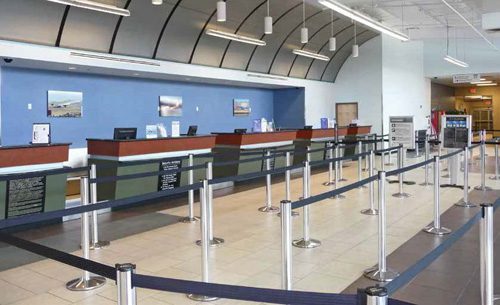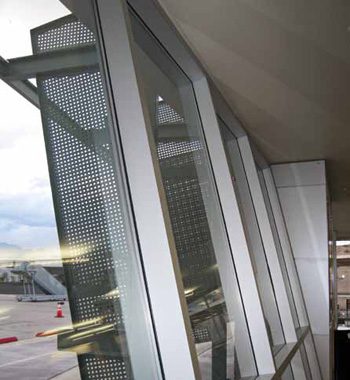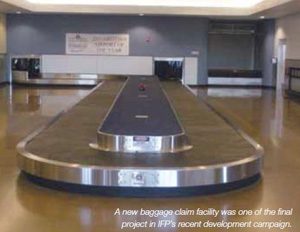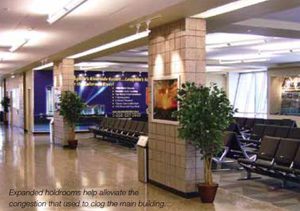
With $20 million worth of airport development in the last five years, Laughlin/Bullhead International Airport (IFP) increased its odds of winning – and won. It was recently named 2011 Airport of the Year by the Arizona Department of Transportation, beating out 82 other contenders.
|
factsfigures Project: Terminal Expansion & Renovations Location: Laughlin (NV)/Bullhead (AZ) Int’l Airport Owner/Operator: Mohave County, AZ / Mohave County Airport Authority Cost: $5.5 million Holdroom Expansion: 2003 – Fall 2005 (Design Through Construction) Terminal Expansion/Renovations: Late 2005 – Spring 2008 (Design Through Construction) Baggage Claim: Construction completed in 2010; dock added in 2011 Contract Engineer: Stantec Architect/Design Subcontractor: DWL Architects + Planners Holdroom Contractor: Larry D Builders Terminal Rehab Contractor: GC Builders (now defunct) Baggage Claim Contractor: TSG Constructors, LLC Baggage Conveyor: T&S Conveyors (now defunct) Baggage Handling System Mfg. & Installer: G&S Airport Conveyor Holdroom Seating Mfg. & Supplier: Krueger Int’l Custom Golf Bag Racks: Fine Line Fabrication Key Benefits: Congestion eased in ticketing area; holdroom facility added; new baggage handling facility with increased security; updated aesthetics |
It also beat tough financial odds: emerging from “near insolvency” six years ago to “solid ground,” as Mohave County Airport Authority officials describe IFP’s current state.
On average, the revamped facility services nearly 250,000 passengers per year, with enplanements increasing 11% in 2010. Many passengers arrive and depart on flights chartered by a nearby casino resort in Laughlin, NV. That means the airport must usher large groups – typically 120 to 140 passengers at a time – through the arrival and check-in process.
Before the terminal building was rehabilitated and expanded in 2008, the facility was too small to properly accommodate the large groups, recalls airport director David Gaines. The ticket counter queuing area was overcrowded with TSA screening and rental car services.
ticket counter queuing area was overcrowded with TSA screening and rental car services.
“Multiple flights scheduled within 20 minutes of each other was utter chaos,” Gaines laments.
Departing passengers delivered to the front curb by resort shuttles were regularly left to locate their baggage, which had been deposited there before their arrival. Not surprisingly, public safety and security became a growing concern.
In 2005, a new holdroom/gate area building opened, and design began to rehabilitate and expand the main 10,500-square-foot pre-engineered building. When Gaines became airport director in 2006, continuing terminal improvements was one of his primary goals.
Concerns relating to baggage being staged on the sidewalk in front of the terminal were addressed with the opening of a new baggage claim facility in 2011.
Overall terminal improvements totaled $5.5 million.
A New Holdroom
The airport’s terminal rehabilitation program started with the addition of a 10,000-square-foot holdroom facility to help alleviate congestion in the main building, recalls Stantec project manager Mark Koester.
As contract engineer for the terminal rehabilitation, Stantec’s services included engineering, project management, architecture (with subcontractor DWL), construction phasing and construction administration.
“The holdroom was kind of the first building block in the overall terminal rehabilitation program,” Koester says.
The steel and concrete masonry unit holdroom building was located to the east of the main building and oversized to accommodate a future second floor.
A covered walkway, spanning about 100 feet, connects the holdroom building with the main terminal building. The updated facility includes three gates (vs. two in the previous holdroom) and additional restrooms.
It also features a new diner. “It’s a much nicer place to sit down and eat while you’re waiting for your flight,” says DWL president Steve Rao.
The holdroom design was motivated by the surrounding landscape, Rao explains. Warm earthtones from large rock outcroppings mix with a pale green shade inspired by Arizona’s state tree, the palo verde.
To maintain views of the casinos located across the Colorado River and to alleviate some of the heat coming in from direct sunlight, DWL designed vertical metal fin sunshades for the structure.
“They have become a prominent identifying feature of the terminal,” Rao notes.
A New Look
Colors and design concepts in the holdroom building carry through to the renovated main terminal. “When you walk in, you feel like you are in a terminal building,” Gaines comments. Jim McCue, an airport industry veteran who retired to Arizona after directing operations at Indianapolis International for 10 years, has watched IFP rebuild and grow. McCue likens its previous, unimproved terminal to a large tin box. “It was a very crowded, dingy, tired building,” he recalls. “The renovation made the building a very customer-friendly facility and a proud part of Bullhead City … IFP is a model for small airports and the way things should be done.”
Jim McCue, an airport industry veteran who retired to Arizona after directing operations at Indianapolis International for 10 years, has watched IFP rebuild and grow. McCue likens its previous, unimproved terminal to a large tin box. “It was a very crowded, dingy, tired building,” he recalls. “The renovation made the building a very customer-friendly facility and a proud part of Bullhead City … IFP is a model for small airports and the way things should be done.”
Skylights and clerestory windows brighten the inside. Ticketing and rental car counters are no longer opposite one another. More than 4,700 square feet of space was added for passenger and baggage screening, and a new baggage conveyor was installed behind the ticket counters.
ticket counters.
“This allows processing to be much more efficient,” Gaines says. “Once ticket counter agents tag a bag, they just turn around and put it on the conveyor where it goes into a new TSA bag screening area.” Previously, checked baggage had to be transported manually from the ticket counter to the TSA screening area.
Everything in the previous terminal building except a few offices was gutted to make room for the changes. That meant all activity occurring there had to be temporarily relocated. Airport administration and rental car services were moved into modular offices with decks added to make them easier to enter and exit. Check-in counters, airline offices and TSA screening were moved to the holdroom building, with temporary restrooms set up outside.
 “Because we were operating in a reduced amount of space,” Gaines explains, “passengers were let off the buses incrementally. We operated like that for eight months. It worked out well because it allowed the contractor and subcontractors to move through the terminal building in a more timely fashion.”
“Because we were operating in a reduced amount of space,” Gaines explains, “passengers were let off the buses incrementally. We operated like that for eight months. It worked out well because it allowed the contractor and subcontractors to move through the terminal building in a more timely fashion.”
While the terminal building was being renovated, other major projects were also taking place: IFP’s 7,500-foot runway was rehabilitated and shifted 500 feet to create a safety area to the north. The terminal access road was also rehabilitated, and public parking was expanded from 90 to 400 spaces.
With simultaneous work occurring on multiple fronts, project managers staged contractors in separate locations. Despite all the extra activity in so many different areas, Gaines reports that none of the improvement projects shut down scheduled operations.
Wait for It
With several multimillion dollar projects underway, funding was not available to build a new baggage claim facility during the terminal rehabilitation and expansion. About two years later, however, the airport added a 4,000-square-foot metal and concrete masonry unit facility near the main building. After a canopy-covered loading dock was added last year, the practice of staging casino groups’ bags on the sidewalk was officially a thing of the past.
baggage claim facility during the terminal rehabilitation and expansion. About two years later, however, the airport added a 4,000-square-foot metal and concrete masonry unit facility near the main building. After a canopy-covered loading dock was added last year, the practice of staging casino groups’ bags on the sidewalk was officially a thing of the past.
Casino employees now retrieve arriving passengers’ bags from an L-shaped, pallet loop baggage claim carousel with an 8-foot-wide-stainless steel baggage slide. In an unusual arrangement, the airport is able to use the same system for outbound baggage as well. Casino drivers load the bags onto the baggage carousel, and passengers retrieve and check in their own bags.
Another uncommon feature of the new baggage system is a metal shroud that connects the carousel’s outer trim to the back wall. The special covering protects the unit’s powering mechanism from the elements, primarily wind-blown sand and dirt. Drive modules are usually not enclosed to facilitate maintenance, explains project manager Randy Dirks of G&S Airport Conveyor.
The system also features a sloped backguard in the loading area to prevent bags from being “overthrown,” adds Dirks. A bag that goes past the conveying surface hits the sloped edge and slides down.
Golf club bags do not go on the conveyor. Instead, a roll-up door allows them to be brought in and placed on custom racks fabricated by Fine Line Fabrication.
 From security cameras to electronic controls on airside doors, Gaines says the new baggage claim facility has everything feasible for a small airport.
From security cameras to electronic controls on airside doors, Gaines says the new baggage claim facility has everything feasible for a small airport.
On a Roll
With myriad airside and landside projects complete, IFP is ready to take on more. “Mohave County Airport Authority has demonstrated it can take on some big projects,” says Gaines. “We are able to match FAA funding and get our projects done in a timely fashion. All the big projects we’ve had on the books are closed now. That bodes well for us when we go back for additional funding.”
Under current regulations, the FAA funds 95% of eligible projects and the state of Arizona, splits the remaining 5% with the airport. Typically, IFP is authorized about $1.4 million of FAA entitlement funds per year, Gaines reports, and airport management has been successful making its case for discretionary FAA funds based on safety, security and capacity needs.
Future projects include a $6 million aircraft rescue and firefighting building that Stantec and DWL have already designed. Extending Runway 16-34, rehabilitating a parallel taxiway and constructing heliport facilities are also on the airport’s short list.
IFP’s master plan calls for a new commercial service area designed to serve the airport for at least 50 years. Plans for land acquisition to facilitate such growth are currently underway, reports Gaines.
  |
“You can’t sit back on your laurels,” he explains. “As airport management, you have to meet today’s demand and plan what you will do next as demand grows … There are days we reach capacity now, so we have to plan for future growth and development.”
|
Assistant Director Selected for Award Before His Death In addition to Laughlin/Bullhead International (IFP) being named 2011 Airport of the Year by the Arizona Department of Transportation, its assistant airport director, the late Darryl Thompson, was named Executive of the Year by the Arizona Airports Association. “Mr. Thompson was a very valuable part of management,” says IFP airport director David Gaines, who received the same honor in 2008. “He kept things moving in the right direction, and we were going in a lot of different directions with various improvement projects. His nomination as executive of the year was well-deserved. In addition to being my right-hand man, he served on the Arizona Airports Association Board of Directors.” Although Thompson passed away before receiving the award, he had been notified of the honor prior to his death. Thompson’s four-year tenure at IFP was preceded by 29 years of operations experience at Indianapolis International Airport. Mark Koester, Stantec project manager, recalls Thompson as a highly technical, detail-oriented person. “He was probably one of the most hands-on airport executives I’ve been around,” says Koester. Gaines credits Thompson for helping accomplish $20 million worth of improvements at IFP. In particular, Thompson laid the groundwork for its future aircraft rescue and firefighting facility, which Mohave County Airport Authority plans to dedicate in his honor when the building is completed in 2013. With many of the improvement projects Thompson focused on already complete, IFP’s new assistant airport director, Jeremy Keating, will help usher in the next phase of the airport’s master plan. |



